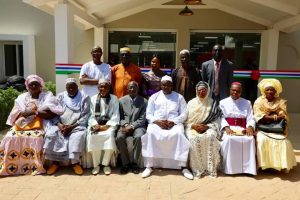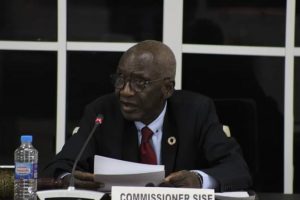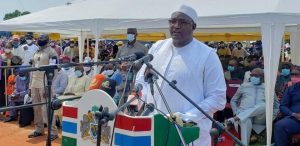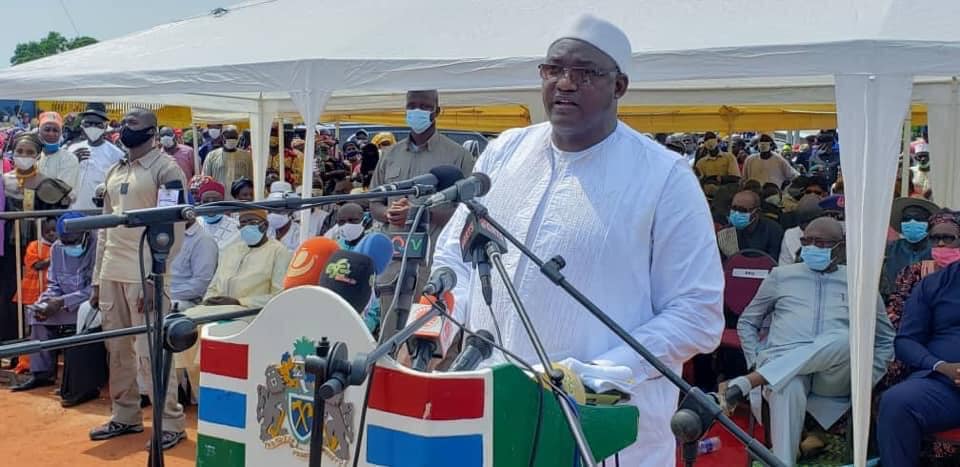


Part III
by Alagi Yorro Jallow.
Mamudu: The Truth, Reconciliation and Reparation Commission (TRRC) has been widely credited for achieving accountability by many with persevering to “wake the Gambia up” from a long slumber of denial, helping the country put historical events in the proper light and order, revealing that Gambians themselves were capable of heinous crimes, keeping a record, preserving, and memorializing such experiences.
The Truth, Reconciliation and Reparations Commission (TRRC) will play an instrumental role in forwarding and bringing visibility of no justice for horrors of twenty-two years of cruel dictatorship unleashed all-out repression of the former President Yahya Jammeh with the publication of a report and such concerns, both as agents of just peace and change, and in service of the pillar of non-repetition under the TRRC’s “Never Again” campaign. The truth-seeking and reconciliation mandate of the TRRC has led to various challenges and even hostilities, which must continuously respond and be managed in the positive.
The Gambia’s Truth, Reconciliation and Reparations Commission (TRRC) emerged in December 2017 through an Act of the National Assembly, receiving presidential assent on January 13, 2018. Officially launched in October of 2018, the 11-member TRRC to investigate former President Yahya Jammeh era of human rights violations from 1994 to 2017, led by the chairperson, Dr. Lamin J. Sise, concluded its public hearing o, May 28, 2021, after heard testimonies from 392 witnesses, the majority of whom were victims of atrocities meted out to innocent civilians by the state, its agents or individuals sponsored by both. The witnesses also included confessed perpetrators.
Mamudu: Madiba reminds us that “No one is born hating another person because of the color of his skin, or his background, or his religion. People must learn to hate, and if they can learn to hate, they can be taught to love, for love comes naturally to the human heart.” Let us remember that truth. Let’s see it as our North Star, let us be joyful in our struggle to make that truth manifest here on earth so that in 100 years from now, future generations will look back and say,” they kept the march going, that is why we live under new banners of freedom.”
“The time for the healing of the wounds has come. The moment to bridge the chasms that divide us has come. The time to build is upon us”, Nelson Mandela said – and described forgiveness as a powerful weapon because “it liberates the soul, it removes fear.”
It was to herald a whole new approach to dealing with the atrocities committed under apartheid: a model at complete odds with the prosecution and punishment exemplified at the Nuremberg trials in 1946. In place of trials, Nelson Mandela created a Truth and Reconciliation Commission (TRC), led by Archbishop Desmond Tutu: the idea was to bring out the truth of what happened by allowing victims and perpetrators to give testimony in public hearings. This, went the theory, would investigate the full extent of the human rights abuses while providing an accurate record and analysis of those years. Furthermore, by giving amnesty to the old oppressors, even killers, it replaced the whole idea of retributive justice with one of restorative justice. This was not about righting past wrongs, but healing the wounds of history, as Desmond Tutu acknowledged.
Mamudu: With the demise of Nelson Mandela, keeping the memory alive is fundamental to the task of ensuring that the mistakes and the misdeeds of the past are not repeated. Mr. Dennis Goldberg’s words in Nigeria in a seminar at the Kukah Institute Research Center in 2013 on the theme – “Healing the Nation: Why Memory Matters.” Mr. Goldberg tried together with Madiba Nelson Mandela in the Rivonia Trials in 1963/64, leading to his incarceration for 27 years. A white member of the South African Communist Party and the Africa National Congress (ANC) holds the singular distinction of organizing a training camp for the first set of freedom fighters trained within South Africa.
Mr. Golberg regretted how the media is reporting Mandela as if he was the sole leader of the ANC. Mandela, he explained, was very conscious of and committed to the principle of collective leadership. As their trial was going on in 1964, there was a decision to send Oliver Tambo out of the country to relay in leadership while they were in jail or killed. It infected the excellent administration and campaign of Tambo that created the fame that accompanied Mandela. Mr. Goldberg explained that as they knew they had no legal defense against the charges they faced, they adopted the strategy of turning the trial into an inquisition of the apartheid regime. Their speeches were aimed not at the judge but at the South African nation, which needed the inspiration to continue with the struggle.
Mr. Golberg opined that at the end of apartheid, they were confronted with two challenges. The documentation of the atrocities committed by the apartheid regime had been deliberately incinerated by the administration in steel furnaces, as shredding them would take too much time. Secondly, between the release of Mandela in 1990 and the takeover of power by the ANC in 1994, the security forces of the apartheid regime had killed 10,000 black people with the hope of creating a crisis and disrupting the transition. While Mandela and the ANC leadership were assuring the white community, their brethren were being massacred. It was in this context that the Truth and Reconciliation Commission was established to keep the memory alive. He added that not all the truth was told, and reconciliation was incomplete. However, the process was necessary for a successful transition.
Mr. Golberg also spoke of the legacy of apartheid on the psyche of the people. He gave the example of the excessively high level of rape and sexual violence in the country. These despicable acts, he explained, were not about sexual gratification. It is about the perverse effects of the humiliation of a people during decades of powerlessness. The man now seeks someone he is more potent than to show “his power.”
Mamudu: On the healing power of forgiveness and reconciliation, Professor Susan Brison for the Study of Ethics and Human Values at Dartmouth College, where she teaches in the Women’s Gender, Sexuality Studies Program, made heart-wrenching lectures ordeal when she explained that as a 35-year-old professional, she was raped. Since then, she had gone through the trauma of trying to remember to continue the struggle against sexual violence and trying to forget so that she could continue with her life.
Transitional Justice refers to forms of judicial and/or non-judicial mechanisms used to redress massive human rights abuses. The instrument, which was developed in the latter part of the last century, became necessary due to the escalation of large-scale human rights abuses since World War 11, beginning with the Nuremberg trial. The principles of transitional justice are rooted in fundamental principles and instruments of human rights such as the Universal Declaration of Human Rights, International Covenant on Civil and Political Rights, and the African Charter on Human and Peoples Rights, all of which
The need for transitional justice mechanisms is rooted in large-scale violent conflicts that multiply atrocities and displacing communities. With its numerous wars, insurgencies, and illegal mass killings by security forces, Africa has the most considerable need for today’s mechanism. Such violence has created a situation in which Africa hosts over one-third of the world’s forcibly displaced persons with 6.3 million refugees and about 15.5 million internally displaced persons (IDPs). In this context, the African Union developed its Transitional Justice Policy (AUTJP) adopted by the Heads of State and Government in February 2019. The policy addresses the prosecutions of those responsible for violations of human rights, the establishment of truth commissions that clarify the causes and consequences of past abuses, the provision of material and symbolic reparations for victims, and institutional reforms to guarantee non-recurrence of conflict. The policy provides a framework and a model for Africa’s conceptualization of transitional justice which is not limited to formal processes and prioritizes informal methods and traditional justice approaches, ethnocultural nuances to justice, socio-economic and developmental dimensions of peace and justice.
Mamudu: Many African countries have implemented transitional justice processes to address the consequences of conflict, which had gross human rights violations. Truth commissions have been set up in South Africa, Sierra Leone, Morocco, Liberia, Togo, Côte d’Ivoire, Kenya, Tunisia, and The Gambia. Accountability mechanisms such as international tribunals and special courts of Rwanda and Sierra Leone; and innovative local and traditional justice practices such as Gacaca in Rwanda, Magamba spirit mediums in Mozambique, Fambul Tok in Sierra Leone, Bashingatahe in Burundi, and Mato Out in Uganda, have been established.
After violent conflicts, reparation is always a complex problem for transitional justice. The damage and wounds created by violence are so profound and devastating that they cannot be repaired. Nonetheless, society must find ways and means of moving forward. Africa has implemented various reparations programs and initiatives over the past three decades to address the consequences of conflict. The idea has been to place victims at the center of transitional justice processes, listen to their experiences and voices and seek pathways to addressing the damage done to them. Establishing the truth of what had been done to victims is always the starting point. The agenda of what could be done should always draw from their narratives and demands. There were extensive discussions on drawing from cultural practices of justice, forgiveness, and compensation for victims.
The importance of the redistributive or socio-economic justice system against the backdrop of Africa’s history of historical injustice through structural inequality and gross human rights violations. Has been widely hailed by the African criminal justice system. The South African generation born free is up in arms against fellow black Africans because they are still miserable. They did not see apartheid and too quickly turn to those they see around them and vent their anger and frustration. Sadly, they miss the point that these African neighbors were not the authors of their misery. The South African Truth Commission did not address these broader issues. In South Africa, Liberia, and Namibia, inequality and land reform are very much on the agenda.
Justice and accountability are central to transitional justice processes. From the International Criminal Tribunal of Rwanda, the Special Court of Sierra Leone, the Special Criminal Court in the Central Africa Republic, and the yet to be established Hybrid Court of South Sudan – Africa has also embarked on accountability mechanisms in pursuit of retributive justice against perpetrators of international crimes and gross human rights violations. Within this context of justice, issues of amnesties, plea bargains, pardons, and alternative forms of punishment have been under scrutiny and severe criticism. The African Union policy offers benchmarks, requirements, and conditions for amnesties and others within a transitional justice context.
Africa’s normative framework recognizes the human (individual) and people (collective) – dimensions of rights through the African Charter on Human and People’s Rights, also known as the Banjul Charter. There is a need to address both the individual and collective consequences of conflict and violations through transitional justice. The African Union policy, therefore, addresses the individual and collective dimensions of conflict and oppression.
Mamudu: The central objective of transitional justice is reconciliation and the rebuilding of trust and social cohesion. This is very difficult as it often requires forgiveness for people who have done great harm. Refusal to reconcile could, however, lead to a recurrence of violence and even more damage. The issue of truth-seeking and truth-telling is only a beginning. It could lead to the evolution of pathways to reconciliation. The wounds are deep, and psycho-social support to address the trauma suffered by victims and the perpetrators of violence is crucial.
Rebuilding social cohesion is even more difficult because high levels of violence indicate that social cohesion had broken down even before the violence. A long history of marginalization, enflaming ethnic and religious divisions, hate speech would have disrupted social cohesion even before the violence began. Memorialization initiatives and programs have been undertaken to preserve the historical memory and instill a “never again” culture for the next generations – school curriculums, national roads, monuments, museums, and memorial sites are among the standard memorialization programs and initiatives undertaken in Africa.
Mamudu: Africa’s history of authoritarianism and the derailing of democracy after independence has often been the driving force in creating and sustaining violent conflicts. The adoption and implementation of political and institutional reforms to consolidate democracy and protect rights are essential in maintaining peace and nation-building. Therefore, diversity management and following the path of ethnocultural justice are crucial elements of transitional justice that enhance social cohesion.

